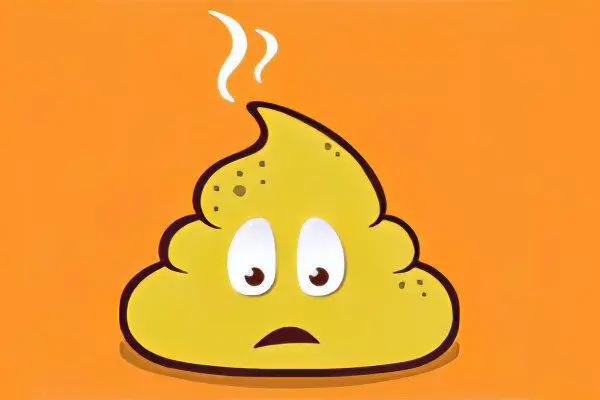Contents

An unusual shade of feces can alert a person who monitors their health and become a reason to see a doctor. The first assumption when a yellow stool appears is a violation of the liver. The dark yellow hue of feces usually does not bother, but the light yellow color of feces is most often a sign of trouble in the gastrointestinal tract.
The composition of the solid fraction of feces is normal:
30% – undigested food;
30% — bacteria;
15% – inorganic substances;
15% – fats;
5% – protein.
The shade of feces depends on the number of bacteria in the human body at the time the stool is formed.
Factors affecting the appearance of yellow stool

Stercobilin, a derivative of bilirubin, gives the typical red-brown hue to stool. If there is not enough stercobilin in the body, the stool becomes yellow. The main reason for the low content of stercobilin is a deficiency of bilirubin due to too rapid passage of feces through the intestines or due to too much mass of feces. Bilirubin is produced in the liver as a result of the conversion of hemoglobin, which moves oxygen from the blood to the internal organs. If pathological processes occur in the liver, bilirubin is formed much less than normal.
Factors affecting stool color change:
Diseases of the liver. Liver diseases such as cirrhosis and hepatitis (as well as gallbladder disorders) can reduce the amount of bile salt excreted in the body. The combination of yellow stools with a change in its consistency is a sign of a deficiency in the body of bile salts, the introduction of an infection, and impaired liver function.
Viral, autoimmune or toxic hepatitis can also provoke a yellow tint of the stool. Most often, these changes are caused by a viral infection. Yellowing of the stool causes mononucleosis, a disease whose symptoms are detected after a blood test.
Diseases of the pancreas. Diseases such as pancreatitis, cystic fibrosis, pancreatic cancer, blockage of the pancreatic duct can cause yellow or pale stools.
Pale yellow faeces may appear after prolonged consumption of large amounts of fatty foods. In this case, the feces acquire an extremely unpleasant odor. Such a reaction of the body to fatty foods may indicate a violation of the functioning of the pancreas.
Cytomegalovirus. Cytomegalovirus infection can leave an imprint on the functioning of the liver, as well as infection with rubella, mumps, alcohol abuse.
Bowel disorders. A change in the consistency of feces often accompanies intestinal disorders caused by the introduction of infection into the human body.
Stress has also been shown to play a role in irritable bowel syndrome. Stress control is an important factor. [1] (on the topic: 10 ways to relieve stress).
Celiac disease. If a person with celiac disease eats gluten (the protein in wheat, rye, and barley), then their immune system attacks this undigested protein, including the tissue in the small intestine, damaging it and disrupting its ability to absorb nutrients.
According to the National Celiac Foundation, over 300 different symptoms are associated with celiac disease. This makes diagnosis difficult. [2]
Giardiasis is a common intestinal infection caused by a microscopic parasite. One of the symptoms of giardiasis is foul-smelling yellow diarrhea.
Yellow products. Carrots (especially fresh carrot juice), sweet potatoes, turmeric, and other yellow-colored foods can make your stool turn yellow. If you regularly have yellow stools due to diet, then you should avoid fatty and processed foods, as well as gluten. In addition, yellowing of the feces may be a side effect of taking drugs with a high content of β-carotene.
A change in the color of the stool from green to yellow can be observed when the intestines are infected, because the speed of transport of digested products through the intestines in this case is extremely high. In this case, the feces do not have time to acquire the usual color. Another reason for acquiring a yellow hue in feces is a deficiency of bile in the body.
Yellow stool in babies – what does it mean?
If you sometimes see yellow stools when changing a diaper, this indicates a shorter time for food to pass through the intestinal tract. Different colors (darker) may indicate that the transit time is slowing down. The stool often changes color. You should definitely consult a doctor only if you notice blood in the stool, this can mean a serious health problem.
When should you see a doctor?

Before seeking medical advice, you should look for the reasons for the appearance of a yellow tint of stool that are available for self-analysis. First you need to make changes in your diet and give up milk and dairy products for a while. If at this time there is treatment with some drugs, it is advisable to refuse them for several days in order to see the reaction of the stool to such changes.
Only after 5-7 days of staying in this mode is it worth contacting a gastroenterologist for a diagnosis. The doctor will prescribe tests and, based on the data obtained, determine the tactics of treatment.
If yellow stool is accompanied by frequent diarrhea, fever, weakness, drowsiness, you do not need to wait a few days, you should get emergency help. It is possible that the cause of these symptoms is an infection or inflammation of the intestines, gallbladder, stomach. Such conditions can cause death and serious complications, so you should immediately get qualified help.
What to do if the feces turn yellow?

Violation of the liver, changing the color of feces to a light yellow tint, occurs after taking the following drugs:
Medicines for the treatment of tuberculosis, epilepsy;
Antibacterial agents;
oral contraceptives;
Methotrexate;
Paracetamol;
NSAIDs.
When such side effects appear, the patient needs to consult a medical worker. If the light yellow color of the feces is not caused by the side effects of drugs or diseases of the gastrointestinal tract, after 2-4 days it will return to normal, changing its color to a red-brown hue. In a normal state of health, there will be no signs of trouble.
Signs of the disease when combined with a light yellow stool:
hyperthermia,
dark urine,
Yellow skin tone.
weight loss,
decreased appetite,
Nausea and vomiting,
Pronounced putrid odor of feces.
A coprogram prescribed by an infectious disease specialist or a gastroenterologist will help identify the cause of poor health and a change in the color of feces to a light yellow tint.









